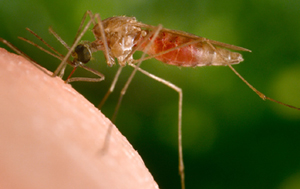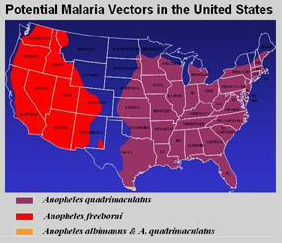 |
 |
| Malaria
Home > |
 |
Preventing Reintroduction of Malaria
in the United States
|
 |
Malaria has been eradicated from the United States since the early 1950s, but outbreaks of locally transmitted malaria still occur occasionally.
|
|
 Episodes of Local Transmission of Malaria in the United States, 1957-2003. (CDC graph) Episodes of Local Transmission of Malaria in the United States, 1957-2003. (CDC graph) |
 |
 |
 |
| Anopheles freeborni, one of the two main potential malaria vectors in the United States. The other is An. quadrimaculatus. (CDC photo) |
 |
 |
Malaria has been eradicated from the United States since the early 1950s. Most malaria cases in this country occur in travelers who have visited or resided in malaria risk areas ("imported" malaria).
Malaria Outbreaks in the United States
However, outbreaks of locally transmitted malaria still arise occasionally in the United States, where Anopheles mosquitoes capable of transmitting malaria ("vectors") are found in most areas.
During such outbreaks, local residents become infected through the bite of local Anopheles mosquitoes, which acquired malaria parasites by feeding on infected persons arriving from malaria-risk areas. (The locally infected residents can, in turn, infect other Anopheles, giving rise to a "secondary wave" of local transmission.)
Between 1957 and 2003, 63 episodes of locally transmitted, mosquito-borne malaria occurred in the United States, the most recent being the outbreak in Palm Beach County, Florida, in the summer of 2003. Such episodes are reminders of the ever present risk that malaria transmission can resume in the United States.
Minimizing Risk
This risk can be minimized by:
To contain and terminate local outbreaks of malaria, local health authorities should:
- Conduct surveillance of
malaria cases
- Ensure prompt diagnosis and treatment of all infected persons
- Sensitize local communities to the risk of malaria
- Encourage personal protection measures to prevent mosquito bites
- Conduct vector control activities
CDC is Available
CDC is available for consultation by state health departments suspecting an outbreak of locally transmitted malaria, and offers a health communication toolkit to assist local health authorities in their investigation and containment activities.
Page last modified : April
22, 2005
Content source: Division of Parasitic Diseases
National Center for Zoonotic, Vector-Borne, and Enteric Diseases (ZVED)
|
 |
|





